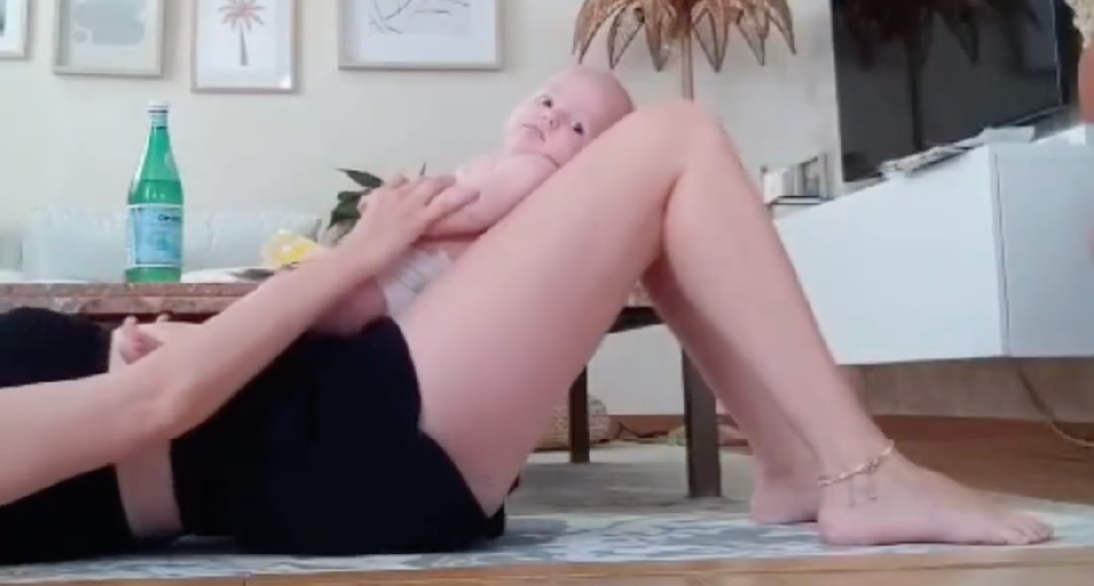Standard crunches or sit-ups are often not recommended for postpartum women, especially when we know a diastasis recti or DRA is present. This is because the way a crunch is usually performed may have the effect of increasing intra-abdominal pressure, pushing your organs outwards against or through the gap, and/or downwards onto the pelvic floor – directions you really don’t want your organs forcefully heading. You can actually see what you’re training your abs to do if you look straight down as you curl up: a cone shape, bread-loaf shape or a pregnant looking belly… these may be signs of diastasis recti, or that your core is not functioning optimally… and not the effect you’re working out to achieve. See animated image >>>
So postpartum exercise specialists and Women’s Health Physiotherapists will often recommend against crunches until the core musculature (including the pelvic floor) is restored and strong enough to withstand the movement.
BUT… and there is a but here… supine spinal flexion (the forward curl-up motion from lying on your back) engages and shortens the rectus abdominis muscle (a good thing). The rectus is the vertical, ‘six-pack’ abdominal muscle, the exact same superficial abdominal muscle that has separated from its midline connective tissue. A diastasis compromises all your ab muscles, both laterally as the gap widens from side to side, as well as lengthways along the stretched and weakened rectus. So diastasis recti exercises to shorten it, if performed correctly, is a good thing.
The other but is that spinal flexion (bending forward, whether lying on your back or in any other position) is a perfectly useful human, functional movement. Sometimes, you want or need to curl your body or bend forward. Sometimes against resistance. Maybe not repetitively, or excessively, but you might want to curl all the same.
So if it’s both potentially beneficial in shortening the stretched-out rectus, and it’s essentially functional, why do we tell you not to do it?
Crunches and diastasis recti
- Before you train the abdominal muscles in this way, you want to ensure the deeper abdominal muscles are actually recruiting (meaning… ‘kicking in’ and working): the Transverse, the Inferior Obliques and the Exterior Obliques all work together, along with the muscles of your pelvic floor. This vital phase of mind-to-muscle reconnection, of learning to recruit and engage the right muscles, first in isolation and then as a unit, must come first. That’s what MUTU System does.
- Also, there are common crunching technique ‘habits’ that could make a diastasis or weak pelvic floor worse, not better. Often crunches are performed whilst sucking in, or holding your breath, causing your stomach to pooch or bulge out and your organs to bear down on your pelvic floor. Often the hip flexors and lower back are taking most of the strain, and the targeted muscles, the rectus abdominis as well as the deep transverse abdominis muscle, are not recruiting at all, whilst the diastasis gap could be widening further.
So unless so you are being guided to gauge whether midline tension of the core musculature is being maintained, and pelvic floor function is controlled and protected, you could do more harm than good. It is preferable and much safer to find alternatives with techniques and patterns which have less potential to harm.
I spent time recently in LA [2015] having been asked to consult for an exercise instructor training company on adapting workouts for pregnancy and postpartum. As we played and experimented with various adapted ‘crunch’ movements, we decided it was time to put this information out there! We both are often heard recommending against crunches, when giving general, online advice where careful personal supervision isn’t possible. By the very nature of the MUTU System online program and blog, we simply cannot be ‘hands-on’ enough to be sure you’re getting it right and therefore caution prevails.
I also wanted to write this because often a Women’s Health Physiotherapist will specifically prescribe a variation of a curl movement at the appropriate stage of her client’s recovery, and I know (because you regularly write to me about it) that you worry that ‘all crunches are bad’. Be mindful that your therapist or Physio will be carefully monitoring and cue-ing breathing and technique to ensure the right muscles are doing the work and full benefits are being achieved. Your stage of restoration is appropriate, you’re recruiting the right muscles…
…The movement is not a bad movement. You just need to be sure you’re getting it right, and that your body is ready for it.
So how do you know if you’re doing it right?
First follow some foundation training (like MUTU or with a specialist Physio) around engaging deeper abdominal muscles, before progressing to full crunches. Then:
Are you able to isolate and find your core muscles?
Try this from lying on your back with knees bent up and feet flat on the floor. Place your hands on your ‘hip bones’ – the bony corners that jut out at the front of your pelvis on each side). Move your fingers slightly inwards and downwards from there, where it’s soft. Exhale as you gently draw your abs inwards, whilst engaging your pelvic floor muscles. Imagine you’re drawing a tampon further up inside you. When you engage your TVA and PFM, you will feel a tensing of the broad flat muscle under the pads of your fingers. It should be tensing downwards, towards your body, not bulging, pushing or straining outwards. If your stomach pooches or pushes away, if you’re holding your breath or the movement is forceful, then you’re working the outer abdominal muscles and TVA isn’t doing its thing.
Your body’s clear signals you should back up a little before progressing further
Watch for these red flags when attempting to engage your core without strain first, then especially when performing any abdominal exercise. If you are experiencing (feeling and/or seeing) any of these symptoms when intra abdominal pressure is increased, you’re not getting it right, and you’re doing more harm than good. Back up. You’re not ready yet.
- Bulging or doming anywhere on your abdomen when you do any exercise
- Bulging in or from your vagina or rectum, or any feeling of heaviness or ‘bearing down’
- Pain – In your back, pelvis, abdomen, hips or leg
- Leaking urine or faeces when you sneeze, laugh or cough; or leaking as you’re rushing to the toilet
For more on this check out this HERE
Try it!
To perform a curl or crunch, keep the range of movement very small at first. By that I mean don’t lift your head and shoulders very high off the ground – there is no muscular benefit to curling right up anyway. And keep the levers short – so knees bent up, feet flat on the floor.
Straight legs, outstretched arms, raised legs or any adjustment that increases the load, increases the strain and will result in bulging. Inhale fully with your head and shoulders completely relaxed on the floor. Then exhale slowly and focus on gently engaging your abdominal muscles as well as your pelvic floor muscles, as you lift your head and shoulders just off the floor. Relax completely back down on the inhale. Watch for doming, straining and be mindful of how your pelvic floor feels.
Increase intensity one small shift at a time: straighten your legs out a little more, but keep knees still bent and feet flat. Take arms outstretched above your head to increase the lever. Hold a small pilates ball or child’s football in your outstretched arms and squeeze it gently between flat palms as you lift, engage and exhale. Just try one of these changes at a time – each will have a big effect on your ability to maintain tension in the midline of your abdomen.
Kim and I ran our thoughts [2015] past highly respected renowned Physiotherapist and teacher Diane Lee of Diane Lee & Associates who confirmed: “Absolutely abdominal curls are important! Just not full abdominal sit ups. All the abs are impacted by DRA (Brauman 2009) and need attention. … It’s a wrong message to say never do a curl up! That isn’t life, but we have to teach the curl-up properly and ensure that tension is maintained in the midline. When the belly bulges or the midline domes that is the clue that the deep system is off and the PFM have to work so much harder to resist the increased pressure. So by all means teach abdominal flexion exercises – with a focus on the strategy and not the reps. … always feel for midline tension and abdominal flattening not bulging…”
I hope this helps clarify a little on the big Crunch Debate! There are no crunches in the MUTU System programs for the reasons discussed above. MUTU is fully comprehensive with variations and cues for how it should feel for you at every stage and we want you to progress safely and see results.
Crunches are not a bad or taboo exercise!
No movement is.
Shortening and strengthening the rectus muscle along its length through carefully supervised increasing ranges of motion, is both functional and beneficial. Foundations first… So You Can do every movement you please 🙂 #MUTUSoYouCan













Thank you again for the great instructions. I’m not ready for a crunch yet but the incontinence is improving . I’m so happy Thank you .
This is fantastic my love, keep listening to your body ❤️
Thank you SO MUCH for writing this! My GP said I didn’t have a separation, but I went to the physical therapist anyway and she said I did. However the exercises she gave me were very crunch like (cross crunches and bicycles). After the experience with the GP it made me skeptical whether or not she was giving me the correct exercises! Thank you for easing my worries!
Hi Wendy. I am so pleased to see this. I have just come away from our Aust Physio National Conference where there seems to a gradual shift from Women’s Health physios in being less forceful with their exercise limitations. I am a physio with specific interest in obstetrics and have been running pregnancy and PN pilates classes for years now. The technique you describe for the chest lift is very effective. I tend to teach the breathing with a breath in at the top of the movement and then regathering the PF/TA at the start of the next exhale and continuing to lower the head and shoulders thru the remainder of the out breath. I find women tend to initially have less control trying to lower during an inhale and manage better to take their in breath while they are static and then “collect up” their TA/PF with the exhale and lower. I feel in the physio world the action of a curl up has been over simplified and hope to see studies paying more attention to the technique, specifically cueing, breath timing, neutral pelvis, etc. Thanks for the blog!
Fantastic article; I just shared it with my FemFusion tribe. I’ve always agreed that crunches aren’t necessarily “bad,” provided they’re done RIGHT (engaging the deep abs and exhaling as you curl up), and done on top of a strong foundation (core reconnection and deep muscle recruitment). I love that you tackled this somewhat “sticky” subject!
Thanks Brianne 🙂